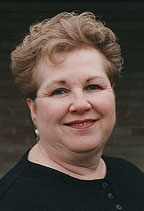
Prepared by
Beth Reames, PhD, LDN, RD,

Diane Linder, EdD, LDN, RD
and

Donna Montgomery, MS
Page 6 of 6
Your child's health care provider
can tell you if your child's weight is too high or too low.
This person will use a growth chart with your child's weight
and height to decide if your child's weight is a problem.
|
|
Eating
and Exercising for Good Health
 Learning good eating and exercise
habits as a child will lead to better health for a lifetime.
Poor eating habits and lack of exercise may lead to excessive
weight gain. Childhood obesity is a major public health
problem in the United States. Obesity in children is linked
with high blood pressure and high blood cholesterol levels.
Overweight children are also more likely to have respiratory
and orthopedic problems. They also often suffer from poor
self-image. Learning good eating and exercise
habits as a child will lead to better health for a lifetime.
Poor eating habits and lack of exercise may lead to excessive
weight gain. Childhood obesity is a major public health
problem in the United States. Obesity in children is linked
with high blood pressure and high blood cholesterol levels.
Overweight children are also more likely to have respiratory
and orthopedic problems. They also often suffer from poor
self-image.
|
Your child's health care provider can tell you
if your child's weight is too high or too low. This person
will use a growth chart with your child's weight and height to
decide if your child's weight is a problem. Remember that
children come in all shapes and sizes. What is healthy
and normal for one child will not necessarily be the same for
another. |
Lack of activity seems to be the major reason many children
are too heavy. Children spend an average of 24 hours a
week watching television. This keeps them from being active.
Children are also exposed to advertisements for high-calorie
foods and may snack continually while watching TV.
|
To prevent your child from becoming overweight,
serve nourishing meals and snacks, encourage active play daily
and set a good example. Children should never be put on
a strict weight loss diet. Restricting calories and nutrients
can alter your child's growth. |
Plan meals and snacks using recommended servings from the
USDA Food Guide Pyramid. Choose non-fat or low-fat milk
and milk products, lean meats, fish, chicken without skin, dry
beans, whole-grain breads, cereals, rice and pasta and plenty
of fruits and vegetables. Use low-fat cooking methods such
as baking, broiling, boiling, roasting, grilling and steaming.
|
Children have a natural desire for sweet foods.
Eating too many sweets will keep them from eating more nutritious
foods. Offer healthy alternatives to high fat, high sugar
snacks and desserts. These alternatives might be fruit,
yogurt or pudding made with non-fat or low-fat milk. |
Your child's appetite is the best guide to how many calories
are needed to grow healthfully. Children don't normally
overeat. If they do, there is a reason. It may be
because meals and snacks are not on a regular schedule.
Maybe someone is encouraging the child to overeat. A child
may also overeat because of stress or depression. Get help
from a health care provider if needed.
 A higher activity level allows
children to eat well without gaining weight and improves their
health. Regular physical exercise offers many health benefits
including: A higher activity level allows
children to eat well without gaining weight and improves their
health. Regular physical exercise offers many health benefits
including:
- Healthy heart, circulatory and respiratory systems.
- Muscular strength, endurance and flexibility
- Helps control weight
- Helps prevent constipation
- Helps maintain healthy bones
- Improved sense of well-being
- Improves sleep
- Contributes to development of social skills
|
Children need to run, jump, skip, hop and move around more.
Try to think of ways to help your child want to be more active:
- Movin' with the Music: Play peppy, fun music
that children enjoy. Organize the children in a safe space
free of obstacles. Start with some stretching activities.
Then play follow the leader with different movement ideas such
as skipping, bending, hopping, twisting, walking, turning or
wiggling like a worm. Rest a few minutes after each song.
- Check out local parks and recreation departments.
Many offer classes in swimming, gymnastics and team sports.
- Set up a badminton or volleyball net in your yard
if you have room.
- Teach children how to play hopscotch.
- Make play or exercise space available in your house,
such as a room with little or no furniture.
- Play Musical Chairs inside when it's raining.
- Take children to parks and school playgrounds which
have swings or climbing equipment.
- Become active with your child. Invite him to
take a walk with you after dinner each day. Take a picnic
lunch on a hike through the woods or fly kites together on weekends.
|
Summary
During the preschool years, a child can be taught healthy
eating habits to last throughout life. Children at this
age should be exposed to many new foods. They will probably
learn to accept and even like them if the foods are presented
in a relaxed and loving atmosphere. It is also important
for the parents of preschool children to practice healthy habits.
The young child will watch family members eat and model eating
behavior after theirs. Following a healthy diet will benefit
both you and your child.
Web Sites to Visit
1. Kids Health www.kidshealth.org
2. Nutrition Cafe http://exhibits.pacsci.org/nutrition/
3. Kids Food Cyber Club www.kidsfood.org
4. Dole 5-A-Day
   [ LESSONS || SITE
MAP || LOCAL AGENTS || RESOURCES || PEOPLE ]
[ LESSONS || SITE
MAP || LOCAL AGENTS || RESOURCES || PEOPLE ]
 Issued in furtherance of Cooperative Extension
work, Acts of Congress of May 8 and June 30, 1914, in cooperation
with the United States Department of Agriculture. The Louisiana
Cooperative Extension Service provides equal opportunities in
programs and employment. Information and Graphics on this site
are copyright protected by LSU Agricultural Center's Louisiana Cooperative Extension Services.
For more information
on the EFNEP program, contact EFNEPMail@agcenter.lsu.edu. Issued in furtherance of Cooperative Extension
work, Acts of Congress of May 8 and June 30, 1914, in cooperation
with the United States Department of Agriculture. The Louisiana
Cooperative Extension Service provides equal opportunities in
programs and employment. Information and Graphics on this site
are copyright protected by LSU Agricultural Center's Louisiana Cooperative Extension Services.
For more information
on the EFNEP program, contact EFNEPMail@agcenter.lsu.edu.
|